#southeast asian wildlife
Text

I think we can guess why the blunt-headed burrowing frog is also known as the balloon frog.
14K notes
·
View notes
Text



Formosan yellow-throated marten (Martes flavigula chrysospila)
Alishan National Recreational Forest, Taiwan
Photos © Staffan Widstrand
430 notes
·
View notes
Text

Wild comes to the temple
1 note
·
View note
Text
"This decade has been one of the most positive for news about tiger conservation of any since conservation science began in earnest, and a highlight must be this mother tiger and her two cubs sighted in Western Thailand, the first such sighting in more than 10 years of close monitoring.
Tigers are stable or increasing across their entire remaining strongholds, including China, Russia, India, Nepal, Bangladesh, Bhutan, and now Thailand—the only Southeast Asian country to see measurable increases in tiger population over the last 12 years.
There may now be as many as 190 tigers in the country, up from 46 logged in a population survey in 2007.
The sight of the mother and her cubs, in the Salak Phra Wildlife Sanctuary, part of the sprawling Western Forest Complex of Thungyai–Huai Kha Khaeng Wildlife Sanctuaries that stretch across 2,400 square miles, is a sign that Thailand’s conservation efforts are really working; not only are tigers breeding outside of core areas, but that must therefore mean there is enough large game, like sambar deer, to feed them.
“This is a big news for us,” said Rattapan Pattanarangsan, the conservation program manager at the Thai chapter of Panthera, a renowned wildcat conservation NGO. “…now we are the source, we can produce tigers from our place. That means our place is safe enough, and has enough prey for the mothers to eat and breed.”
Neighboring Laos, Cambodia, and Vietnam haven’t been able to make meaningful progress in restoring their tigers, and if they ever needed a few individual animals, Thailand now has a stable, growing population that is adapted to similar forest conditions.
Pattanarangsan told The Guardian that creative efforts to stop poachers, such as by working together with ranchers to place early warning cameras on forest trails have worked significantly.
Reductions in commercial bamboo harvesting have also reduced human-tiger conflict, and the animals look poised to continue flourishing in the western rainforests of the country."
-via Good News Network, January 8, 2024
#tiger#tigers#wildlife#conservation#endangered species#thailand#thai#poachers#big cats#good news#hope#hope posting#baby animals#tiger cub
847 notes
·
View notes
Text
The Oriental Blue Clearwing Moth: these moths were regarded as a "lost species" for more than 130 years, until they were finally sighted again in 2013
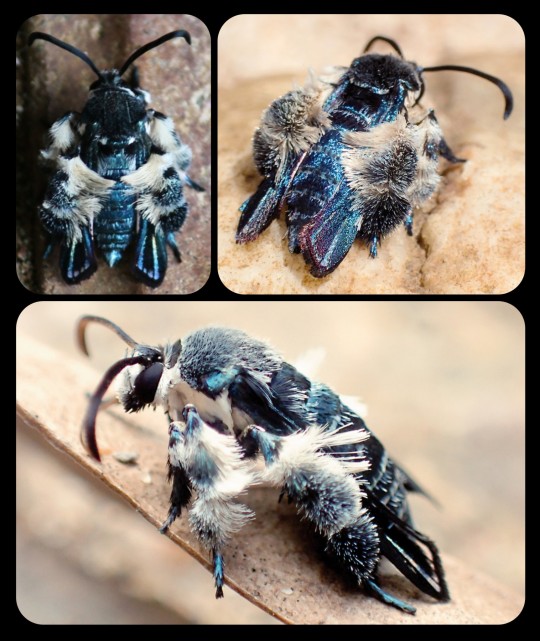
For more than 130 years, the Oriental blue clearwing moth (Heterosphecia tawonoides) was known only from a single, badly damaged specimen that was collected in Sumatra in 1887. There were no recorded sightings of this species again until 2013, when entomologist Dr. Marta Skowron Volponi unexpectedly found the moths feeding on salt deposits that had accumulated along the riverbanks in Malaysia's lowland rainforest.

These moths were observed by researchers again in 2016 and 2017, and research indicates that the moths are actually bee-mimics, as they mimic the appearance, sound, behavior, and flight patterns of local bees. Their fuzzy, bright blue appearance might seem a little out of place for a bee-mimic, but those features do appear in several different bee species throughout Southeast Asia.
When the moths are in flight, they bear a particularly strong resemblance to the bees of the genus Thyreus (i.e. cuckoo bees, otherwise known as cloak-and-dagger bees), several of which are also bright blue, with banded markings, dark blue wings, fuzzy legs, and smooth, rounded antennae. The physical resemblance is compounded by the acoustic and behavioral mimicry that occurs when the moths are in flight.
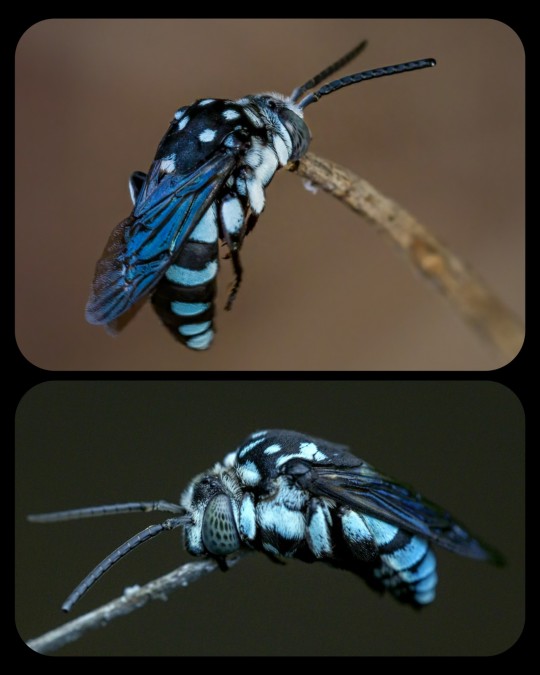
Cloak-and-Dagger Bees: the image at the top shows an Indo-Malayan cloak-and-dagger bee (Thyreus novaehollandiae) in a sleeping position, holding itself upright with its mandibles clamped onto a twig, while the image at the bottom shows a Himalayan cloak-and-dagger bee (T. himalayensis) resting in the same position
The moths also engage in "mud-puddling" among the various bees that congregate along the riverbanks; mud-puddling is the process whereby an insect (usually a bee or a butterfly) draws nutrients from the fluids found in puddles, wet sand, decaying plant matter, carrion, animal waste, sweat, tears, and/or blood. According to researchers, the Oriental blue clearwing moth was the only lepidopteran that was seen mud-puddling among the local bees.
Dr. Skowron Volponi commented on the unusual appearance and behavior of these moths:
You think about moths and you envision a grey, hairy insect that is attracted to light. But this species is dramatically different—it is beautiful, shiny blue in sunlight and it comes out during the day; and it is a master of disguise, mimicking bees on multiple levels and even hanging out with them. The Oriental blue clearwing is just two centimeters in size, but there are so many fascinating things about them and so much more we hope to learn.
This species is still incredibly vulnerable, as it faces threats like deforestation, pollution, and climate change. The president of Global Wildlife Conservation, which is an organization that seeks to rediscover "lost species," added:
After learning about this incredible rediscovery, we hope that tourists visiting Taman Negara National Park and picnicking on the riverbanks—the home of these beautiful clearwing moths—will remember to tread lightly and to take their trash out of the park with them. We also recommend that Americans learn about palm oil production, which is one of the primary causes of deforestation in Malaysia.
Sources & More Info:
Phys.org: Bee-Mimicking Clearwing Moth Buzzes Back to Life After 130 Years
Mongabay News: Moth Rediscovered in Malaysia Mimics Appearance and Behavior of Bees to Escape Predators
Journal of Tropical Conservation Science: Lost Species of Bee-Mimicking Clearwing Moth, H. tawonoides, Rediscovered in Peninsular Malaysia's Primary Rainforest
Frontiers in Zoology: Southeast Asian Clearwing Moths Buzz like their Model Bees
Royal Society Publishing: Moving like a Model - mimicry of hymenopteran flight trajectories by clearwing moths of Southeast Asian rainforests
Medium: Rediscovery in a Glint of Blue
re:wild.org: The "Search for Lost Species" Project
#lepidoptera#moths#heterosphecia tawonoides#oriental blue clearwing moth#entomology#insects#cute bugs#nature#animals#lost species#mimicry#evolution#bees#southeast asia#Malaysia#colorful moths#bee mimic#science
78 notes
·
View notes
Text
Palm Oil
The demand for Palm Oil in products has led to massive deforestation in Sumatra, Borneo and other Southeast Asian countries, leading to habitat loss for many species, ranging from tigers to numerous species of bat.
So what? You ask. It isn't like there's anything I can do about it.
Well, guess what, there is something you can do, and it doesn't involve a boycott.
Just look for this label on products containing palm oil:

image description: the RSPO certified symbol with a green palm and the words 'Certified sustainable palm oil' in black and 'RSPO' in orange around it
This symbol indicates that the palm oil used meets the sustainability standards of the Roundtable on Sustainable Palm Oil (RSPO).
Further Reading:
RSPO website: https://rspo.org/
Get involved as an Individual | RSPO: https://rspo.org/as-an-individual/
RSPO ScanApp (France only): https://rsposcanapp.com/
Products with RSPO Label | RSPO: https://rspo.org/as-an-organisation/our-trademark/products-with-rspo-label/
Palm Oil Scorecard | World Wildlife Fund: https://palmoilscorecard.panda.org/#/home
PalmOil Scan | Cheyenne Mountain Zoo and World Association of Zoos and Aquariums: https://www.waza.org/news/waza-palm-oil-scan-app/
29 notes
·
View notes
Text








THE PRINCE DIARIES ♚
6 NOVEMBER 2023 || SINGAPORE VISIT : DAY 2 (3/3) - UNITED FOR WILDLIFE GLOBAL SUMMIT
The Prince of Wales attended the United for Wildlife Global Summit at the Flower Dome of the Gardens by the Bay as his final engagement on his first full day in Singapore as part of the 2023 Earthshot Week in the country.
United for Wildlife was founded by William and The Royal Foundation in 2014, and it aims to make it impossible for traffickers to transport, finance, or profit from illegal wildlife products.
This year, the summit was focused on bringing together the organization's Taskforces, partners & law enforcement to show the power of collaboration to end the illegal wildlife trade.
William gave a keynote speech at the event, speaking about the incredible job being done by the Singaporean authorities have taken to tackle illegal wildlife trade, noting that the Republic had seized about 34kg worth of rhinoceros horns worth $1.2 million at Changi Airport in 2022.
He also announced United for Wildlife's new partnership with Mandai Nature to build on the ongoing work for United for Wildlife’s Southeast Asian chapter. And about the creation of the world's first international statement of principles, agreed by governments with signatories including Australia, Canada, New Zealand, the UK, the US, South Africa and Singapore. They will commit to regular cooperation to combat money laundering from transnational criminal syndicates engaged in the illegal wildlife trade.
A partnership was also formalised between United for Wildlife and Interpol through a letter of intent pledging to combine their operational expertise and global networks to tackle illegal wildlife trade.
#prince of wales diaries 23#prince of wales diaries 2023#prince of wales diaries#the prince of wales#prince of wales#prince william#william wales.#british royal family#british royals#royalty#royals#brf#royal#british royalty#duke of cambridge#6112023#Singapore23.2.3#Singapore23#Singapore23.2#royaltyedit#royalty edit#royaltygifs#royalty gifs#my gifs
47 notes
·
View notes
Note
top 5 felines ever to exist on the planet?
oooohohohoho. so. technically, taxonomically speaking "feline" means only the little cat subfamily, so we'll be focusing on them. pls read this in the burger king foot lettuce voice btw
5. jaguarundi. idk why but he's giving otter or weasel, and allegedly they move like a mustelid too. their short legs and long bodies allow them to keep a low profile, and likely evolved convergently from weasels because it was a useful hunting adaptation. they also come in two colors, which i did not know until looking for facts for this post! (recently the first ever albino one was discovered too, so i guess technically three? but being white would be really bad for a wild cat so lets maybe not intentionally go for that morph.)
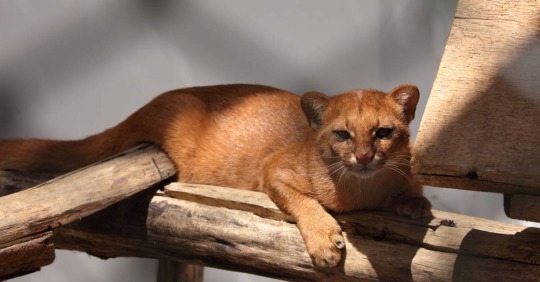

4. lynx (all variants). two words: BIG PAWS. the canadian lynx is so dependent on the snowshoe hare as a food source that its population directly correlates with the hare population in any given area. when there is a boom in hare births, there is also a boom in lynx births and migrations to the area. when the hares have been hunted down to a smaller population, the lynxes either starve or leave.

3. asiatic golden cat. tell me this is not the prettiest motherfucker you have ever seen in your life. sometimes known as fire cats, it was believed in some parts of southeast asia that carrying even one hair from a golden cat could ward off tigers. they are one of the least studied asian cats, but collar trackers suggest they may be more diurnal than most felines. despite their name, they are not closely related to the african golden cat, which is part of the serval lineage of cats.

2. mountain lion. that is right, this human-sized greek god of an animal is more closely related to domestic cats than to any true big cat! mountain lions have been known to bite the back of the neck and paralyze their prey by piercing the spinal cord! it's a good thing they're normally shy. rest in peace P-22, the griffith park mountain lion. he inspired a new generation of urban conservationists, and i'm glad the indigenous people of the area were granted rights to his body to give him a proper sendoff. he lived a long life for a puma, but his euthanasia due to pesticide-related illness is a stark reminder of how severely wildlife depleted our world is becoming.

1. african black-footed cat. these little serial killers have THE highest k/d ratio of the entire true cat subfamily, stat padding a disrespectful 60% of all the prey they go after. compare that to the mighty tiger's 10% success rate, and you will begin to understand why they make this regular ass cat live in the zoo.

29 notes
·
View notes
Text
Geokichla longitarsus Hume, 2022 (new species)

(Select bones of Geokichla longitarsus [scale bars = 10 mm], from Hume, 2022)
Meaning of name: longitarsus = long [in Latin] foot [in Greek]
Suggested common name: Mauritius ground thrush
Age: Holocene (more precise age uncertain)
Where found: Vallée des Prêtres, Port Louis, Mauritius
How much is known: Several limb bones, including a tarsometatarsus (fused ankle and foot bones), humeri (upper arm bones), and tibiotarsi (fused shin and ankle bones). It is unknown whether any of these bones belonged to the same individuals.
Notes: Geokichla is a genus of thrushes from Afro-Eurasia, of which many species feed primarily on the ground. G. longitarsus is the first extinct species of Geokichla to be identified. In terms of skeletal anatomy, it was similar to but slightly larger than the extant orange-headed thrush (G. citrina) of Southern and Southeast Asia. G. longitarsus may have descended from Asian thrushes that reached Mauritius during a period when sea levels were lower than they are today, conditions that would have exposed more land in the island archipelagos of the Indian Ocean and made overseas crossings more manageable.
Over 60% of bird species unique to Mauritius are known to have gone extinct in recent times, including G. longitarsus. No firsthand observations of this thrush have been found in records of Mauritian fauna, so it is possible that it died out before the arrival of the Dutch (who wrote the oldest known accounts of the wildlife of Mauritius in the late 16th Century). The introduction of black rats by Arab traders in the 14th Century may have been what caused the extinction of G. longitarsus, as a small, ground-dwelling bird unfamiliar with mammalian predators would have probably been very vulnerable to rat predation.
Reference: Hume, J.P. 2022. A new subfossil ground thrush (Turdidae: Geokichla) from Mauritius, Mascarene Islands. Bulletin of the British Ornithologists' Club 142: 388–403. doi: 10.25226/bboc.v142i4.2022.a2
#Palaeoblr#Birblr#Dinosaurs#Birds#Geokichla longitarsus#Mauritius ground thrush#Holocene#Africa#Telluraves#2022#Extinct
18 notes
·
View notes
Text
What If your favorite historical figure is in Ikemen Vampire Universe
My Favorite Is:
Raden Saleh Syarif Boestaman

Potrait painting Saleh Syarif Boestaman by Carl Johann Baehr
Raden Saleh Syarif Bustaman
(1811 – 23 April 1880) was born in the village of Terboyo, near Semarang on the island of Java in the Dutch East Indies (present-day Indonesia).
He was born into a noble Hadhrami family; his father was Sayyid Husen bin Alwi bin Awal bin Yahya. He was the grandson of Sayyid Abdullah Bustam through his mother, Raden Ayu Sarif Husen bin Alwi bin Awal. Through his sister, Roqayah, Raden Saleh was uncle by marriage to the famous religious leader Habib Ali Kwitang.
He was considered to be the first "modern" artist from Indonesia (then the Dutch East Indies), and his paintings corresponded with nineteenth-century romanticism which was popular in Europe at the time. He also expressed his cultural roots and inventiveness in his work.

Potrait painting of Raden Saleh by Friedrich Carl Albert Schreuel in 1840.
Young Raden Saleh was first taught in Bogor by the Belgian artist A.J. Payen. Payen acknowledged the youth's talent, and persuaded the colonial government of the Netherlands to send Raden Saleh to the Netherlands to study art. He arrived in Europe in 1829 and began to study under Cornelius Kruseman and Andreas Schelfhout.
It was from Kruseman that Raden Saleh studied his skills in portraiture, and later was accepted at various European courts where he was assigned to do portraits. While in Europe, in 1836 Saleh became the first indigenous Indonesian to be initiated into Freemasonry. From 1839, he spent five years at the court of Ernest I, Duke of Saxe-Coburg and Gotha, who became an important patron.
From Schelfhout, Raden Saleh furthered his skills as a landscape painter. Raden Saleh visited several European cities, as well as Algiers. In The Hague, a lion tamer allowed Raden Saleh to study his lion, and from that his most famous painting of animal fights was created, which subsequently brought fame to the artist. Many of his paintings were exhibited at the Rijksmuseum in Amsterdam. Several of his paintings were destroyed when the Colonial Dutch pavilion in Paris was burnt in 1931.

Studio Potrait in 1872
23 April 1880, Saleh suddenly fell sick. He claimed that he was poisoned by one of his servants, and subsequently died; however post-mortem examination showed that his circulatory system was disrupted due to a clot near his heart. Saleh was buried two days later in Kampung Empang, Bogor. As reported in Javanese Bode newspaper, 28 April 1880, his funeral was "attended by various landheeren [landlords] and Dutch officials, and even by curious students from nearby school.
Raden Saleh Painting
During his stay in Paris, Saleh met Horace Vernet whose painting frequently took themes of African wildlife. Compared to Vernet, Saleh's painting seems to be more influenced by the romantic painter Eugène Delacroix. This could be seen in one of Saleh's work, Hunting Lion, 1840, which has similar composition to Delacroix's Liberty Leading the People. However, Werner Kraus, a researcher in the Southeast-Asian Art Center of Passau, Germany, said that Saleh "never mentioned Delacroix. Perhaps he saw Delacroix's, and possibly Vernet's, works during an exhibition.
And one of my favorite painting by Raden Saleh is:
The Arrest of Pangeran Diponegoro

Raden Saleh is particularly remembered for his historical painting, The Arrest of Pangeran Diponegoro, which depicted the betrayal of the rebel leader Prince Diponegoro by the colonial government, thus ending the Java War in 1830. The Prince was tricked into entering Dutch custody near Magelang, believing he was there for negotiations of a possible cease-fire. He was captured through treachery and later deported.
The event had been previously painted by a Dutch painter Nicolaas Pieneman, commissioned by Lieutenant General Hendrik Merkus de Kock. It is thought that Saleh saw this painting during his stay in Europe. Saleh made significant changes in his version of the painting; Pieneman painted the scene from the right, Saleh from the left.
Pieneman depicts Diponegoro with resigned expression, while in Saleh's he appears to be outraged. Pieneman gave his painting the title Submission of Prince Diponegoro, while Saleh gave The Arrest of Pangeran Diponegoro. It is known that Saleh deliberately painted Diponegoro's Dutch captors with large heads to make them appear monstrous, as opposed to the more proportionally depicted Javanese.

De onderwerping van Diepo Negoro aan luitenant-generaal baron De Kock by Nicolaas Pieneman 1830–1835.
Raden Saleh’s work has been regarded as a sign of incipient nationalism in what was then the Dutch East Indies / Indonesia. This can also be seen it the depiction of Diponegoro's men. Pieneman had never been to the Indies, and so depicted Diponegoro's men in a more Arabic fashion. Saleh's version has a more accurate depiction of native Javanese clothing, with some figures wearing batik and blangkon.
Saleh finished this painting in 1857 and presented it to Willem III of Netherlands in The Hague. It was returned to Indonesia in 1978 as a realization of a cultural agreement between the two countries in 1969, regarding the return of cultural items which were taken, lent, or exchanged to the Dutch in the previous eras. Even though the painting did not fall under any of those categories, because Saleh presented it to the King of the Netherlands and it was never in the possession of Indonesia, it was nevertheless returned as a gift from the Royal Palace of Amsterdam, and is currently displayed at the Merdeka Palace Museum in Jakarta.
My sketch prototype

I'm still trying to improve my digital art skill. And i think i will try to write story au about him in Ikevamp universe. I'm sorry for my bad English 😭😭
2 notes
·
View notes
Text
Thailand's World Heritage Sites: A Look Back in Time

Join us on an enthralling adventure to Thailand, where historical wonders and cultural wonders await at world heritage sites in Thailand. We welcome you to discover the charm of these unique locations and plan your Thailand excursions to witness the country's intriguing legacy as we dig into Thailand's rich historical places. Thailand has some amazing UNESCO World Heritage Sites, each of which offers insight into the country's illustrious history and distinct cultural legacy. Let's go on an immersive exploration of these historical places in thailand:
1. Ayutthaya Historical Park
Explore the Ayutthaya Historical Park ruins, which were once the magnificent headquarters of the medieval Ayutthaya Kingdom. Admire the antique temples, monasteries, and statues of the Buddha that stand as a testament to the city's former glory. Ayutthaya, a UNESCO World Heritage Site since 1991, transports you through centuries of Thai history.
2. Sukhothai's Historic City
The Historic City of Sukhothai, another UNESCO World Heritage Site, takes you to the 13th century. Explore the ruins of this medieval capital, which is known for its beautiful architecture and serene Buddha sculptures. The Sukhothai Historical Park provides a calm atmosphere among other places to visit in Thailand that is excellent for taking a stroll around the old city.
3. Thungyai-Huai Kha Khaeng Wildlife Reserve
Thungyai-Huai Kha Khaeng Wildlife Sanctuary is one of the world's largest and most significant natural heritage sites located in Western Thailand. This expansive natural habitat is inhabited by a wide variety of plants and animals, some of which are at risk of extinction, such as the Asian elephant and the Indochinese tiger. You can immerse yourself in the raw and untouched splendor of this protected refuge by going on an exciting safari.
4. Udon Thani's Ban Chiang Archaeological Site
Visit the Ban Chiang Archaeological Site, which has been designated a UNESCO World Heritage Site since 1992. This ancient community in world heritage sites in Thailand
is recognized for major archaeological findings, like pottery and bronze artifacts that give unique insights into Southeast Asia's prehistoric societies. Investigate the museum.
5. Dong Phayayen-Khao Yai Forest Complex
The Dong Phayayen-Khao Yai Forest Complex is another UNESCO World Heritage Site located in the beautiful woods of Eastern Thailand. This enormous natural region is a biodiversity hotspot, home to a variety of habitats and fauna, including Asian elephants, gibbons, and tigers. Set off on a fascinating trip with historical places in Thailand through the lush wilderness, and an abundance of flora and wildlife.
6. Historic Town of Sukhothai
The Dong Phayayen-Khao Yai Forest Complex is another UNESCO World Heritage Site located in the beautiful woods of Eastern Thailand. This enormous natural region is a biodiversity hotspot, home to a variety of habitats and fauna, including Asian elephants, gibbons, and tigers. Set off on a fascinating trip with thailand tours through the lush wilderness, complete with waterfalls, limestone hills, and an abundance of flora and wildlife.
The Historic Town of Sukhothai and Surrounding Historic Towns extend the cultural investigation beyond the main zone of Sukhothai Historical Park to encompass Kamphaeng Phet. More historical ruins and constructions that highlight ancient Thailand's architectural grandeur may be found here. Enjoy the tranquility of the historical places in Thailand while learning about the vivid history of each of these heritage towns.
Conclusion
the ruins of ancient capitals to the raw grandeur of animal reserves, each location provides a one-of-a-kind and awe-inspiring experience. Make sure to include these wonderful places in your Thailand holiday packages 2023. Immerse yourself in Thailand's rich legacy and see the splendor of its past and present. Prepare to go on an enthralling tour across Thailand's heritage sites, and see the history and culture of this dynamic country emerge before your eyes!
4 notes
·
View notes
Text

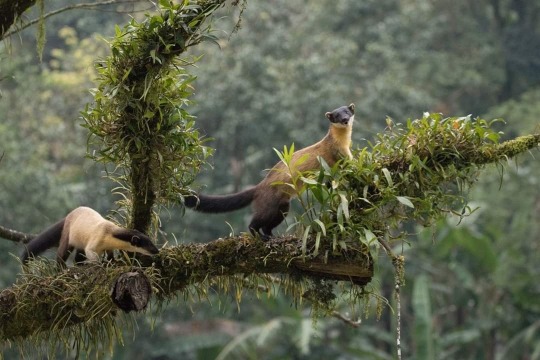
Indochinese yellow-throated martens (Martes flavigula indochinensis)
Mae Wong National Park, Thailand
Photos by Niran Anurakpongsathorn
189 notes
·
View notes
Note
Southeast Asian pride anon here 🙋🏻♀️👋🏼 just wanted to tell you thank you so so much for allowing me to open up last night Vanessa! You don’t have to post this if you’re not comfortable but for you to even read it would mean a lot! This is just what I’ve learned from my family members, personal experiences, and other war refugees of the Vietnam war so what I share may be different or inaccurate from others! I’m not doing this to target or hate any person on here! Just wanna spread the message 🙏🏼
There’s a debate of jungle Asian vs. fancy Asian:
Jungle Asian mainly applies to southeast Asians who are rooted from Vietnam, Myanmar (Burma), Brunei, Thailand, Cambodia, Laos, Philippines, Indonesia, etc. who are still considered 3rd world countries. When being called a Jungle Asian, monkey, morena, asian slave, I considered them racial slurs because these countries my family lived and fought in the war are located right where the equator, which is surrounded by jungles commonly consisting of monkeys and other wildlife animals who are considered uncivilized. They referred to us as uncivilized animals because we’re located near an area where it’s hot, humid, and filled with wild animals. As well as our skin tone, us Southeast Asians are more tan than other Asians. From what my grandmother told me, the people around her were often called Asian slave because of the hard labor they faced and were used as comfort women to the soldiers fighting in the war in ~1973-1975. They were subjected to r@pe by South Korean troops.
Fancy Asian mainly applies to East Asians who are rooted from Japan, Korea, China, etc. who are more modern and well-developed. In my own experience, I’ve received the most discrimination and been called jungle Asian, monkey, Asian slave, by East Asians. Again this isn’t a way to hate on them at all! Just stating what I’ve gone through in my own life.
I’ve put in tiktok videos that I think do a good job at breaking down both terms to help better understand if my message gets too wordy!:
https://www.tiktok.com/t/ZT883THnR/
https://www.tiktok.com/t/ZT88337yR/
https://www.tiktok.com/t/ZT883qdva/
Hello! Thank you so much for being willing to share this with me! I’m always looking to educate myself more on a variety of cultures! Please continue to share as you think or come across anything else! ❤️❤️❤️
3 notes
·
View notes
Text
Holidaying in Singapore in April: Top Things to do in Singapore in April
Singapore is one of the best tourist destinations in Southeast Asia. The tiny country, which is also a city, is home to numerous natural, manmade, cultural, and modern attractions, making it a perfect place to holiday with your family and friends. But as Singapore is located closed to the equator, the city-state has a tropical climate. Singapore is hot and humid throughout the year. But it also rains in the country for most of the year. Hence, the best time to visit Singapore is during the dry season; April is one of them.
Singapore Weather in April
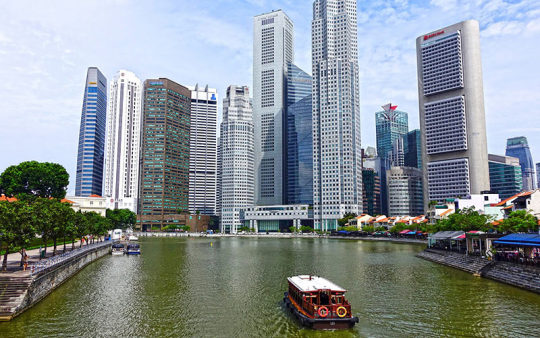
The temperature in April in Singapore can go above 30-degree C. In short, it is quite warm during the day. Humidity is also at a high during this month. The good thing about April is that the chance of rainfall is minimal in this month. So, you can step out without the fear of being drenched in the rain.
Best Things to do in Singapore in April
As the chances of rainfall are less, you can spend a lot of your time exploring the outdoor attractions. But as it is hot and humid during the month, you must take necessary precautions to stay cool and hydrated during your excursions. Here are some of the things to do and places to visit in Singapore in April.
Ingnite the Adventurous in You at the Universal Studios Singapore

Thrill and adventure are what await you at the Universal Studios Singapore. A part of Sentosa World, Universal Studios is a theme park that promises lots of fun and adventure. The park is divided into seven different zones, namely Hollywood, New York City, Ancient Egypt, The Lost World, Sci-Fi City, and Far Far Away. Each of these zones is filled with thrilling rides and fun attractions. Universal Studios promises an amazing time for people of all ages.
Enjoy a Picnic at the Gardens by the Bay

Singapore is home to some of the best tourist attractions in the world, and Gardens by the Bay is a prime example of the same. Spanning an area of 101 hectares, Gardens by the Bay is a nature oasis amidst the concrete jungle. The place includes numerous gardens and conservatories where nature meets technology. When the sun cools down, head over to one of the picnic areas in the gardens to enjoy some quiet time with your loved ones. Do not forget to explore the place, as there is much to see and do at the Gardens by the Bay, the Supertree Grove being the best among them.
Go on an Exciting Singapore Night Safari
Singapore has plenty of wildlife parks and bird parks where you can meet several species of animals and birds in their natural environment. But Singapore Night Safari offers a unique wildlife experience. This is the perfect place to meet nocturnal animals. You can go on a Safari Adventure Tour, where you can explore the park on a buggy or on foot. During your tour, you will get to see a wide variety of animals like Asian elephants, Indian rhinos, Malayan tiger, and Malayan tapir in their natural habitat. Creatures of the Night and TwiLIGHT Performance are two shows you must watch here.
Click Pictures with Your Favorite Celebrity at Madame Tussauds

Madame Tussauds does not need an introduction. A visit to this amazing, world-class wax museum will give you the chance to click photos with your favorite Hollywood and Bollywood celebrities as well as sportspersons from around the world. Madame Tussauds Singapore has a Marvel Universe where you will get to enjoy a unique 4D experience. Images of Singapore and Spirits of Singapore Boat ride will give you a glimpse of the history and local life of the city.
Watch a Play at the French Theatre Festival
If you are an enthusiast of French Theater, you will be delighted to know that Les Apprentis Comediens is organizing the French Theatre Festival in Singapore. The festival is on the 20th and 21st of April. During these two days, you will get to see three amazing theatre productions that raise women’s issues, promote gender equality, and encourage women empowerment in Singapore. The plays to be performed here are Boeing Boeing, The Vagina Monologues, and Tartuffe: The Imposter.
View the Underwater World at S.E.A. Aquarium

Another gem of an attraction located in Singapore’s Sentosa World is the S.E.A. Aquarium. With 40 habitats and more than 10,000 marine animals, this place will give you a close look at the underwater world. Some of the marine ecosystems you will find here are the Straits of Malacca & Andaman Sea, Bay of Bengal, the Great Lakes of East Africa, etc. Apart from viewing stings rays, sharks, jelly fishes, etc., you will also get to enjoy some unique experiences at this aquarium, including an aquarium dining experience.
Take in the Gorgeous Sights of Singapore while Riding the Singapore Flyer

Singapore has some of the tallest buildings in the world, and the best way to see the entire city in one-go is by going on a Singapore Flyer. This observation wheel is 165 meters in height and gives you a 360-degree view of the city. The wheel has 28 air-conditioned capsules that complete one rotation in 30 minutes. Apart from simply viewing the various attractions of the city, you can also choose to dine in one of the capsules. The best time to go on a Singapore Flyer ride is at night, when you can see the city in all its glory.
Apart from the ones mentioned above, there are plenty of other things that will keep you engaged and entertained in Singapore. But whenever you decide to step out, make sure you apply sunscreen and carry a bottle of water to protect yourself from the effects of sun in April.
0 notes
Text
8 famous trekking places to visit in Laos

The scenic Southeast Asian landscapes of Laos beckon adventurous souls with its rugged terrain and pristine natural beauty. Adventure enthusiasts are drawn to this unearthly country by its collection of hiking trails, each offering unique attractions, cultural encounters and outdoor adventure a mix of diversity From remote mountain villages to dense forests and waterfalls Laos has eight popular hiking destinations to explore off the beaten path promise unforgettable experiences the prospective pilgrims
Make your way along Laos’ hiking trails and discover hidden gems in its lush countryside. Whether hiking the misty peaks of the northern mountains or deep into the forests of the south, these trekking spots offer a glimpse of Laos’s rich ecology and traditional way of life Be prepared to be independent will imbue Laos’s natural wonders and cultural heritage
8 famous trekking places to visit in Laos
1. Luang Namtha: Exploring Tribal Villages
Luang Namtha province in northern Laos has some of the country’s most popular travel experiences. Walking through Luang Namtha usually involves trekking through dense forests, crossing scenic rivers and visiting remote villages inhabited by ethnic minorities. Travelers can embark on multi-day trips visiting villages inhabited by the Akha, Hmong and Lahu tribes, providing opportunities for cultural immersion and authentic encounters with local people
2. Muang Ngoi Neua: Peaceful by the river
For a wonderful and tranquil walk, Muang Ngoi Neua is the best place in northern Laos. Accessible only by boat, this remote riverside village is a gateway to pristine nature and traditional Lao culture. Much of the walking trail from Muang Ngoi Neua runs through dense forest, past waterfalls and along the tranquil Nam Ou River, offering travelers a peaceful escape from modern times the chaos of life
3. Phongsali: Remote mountain roads
Venture off the beaten path to Phongsali province in northern Laos, where rugged mountainous terrain and remote ethnic minority villages await intrepid travelers Trekking in Phongsali offers unparalleled opportunities exploring the infinite beauty of the mountains of Laos through mist covered forests, terraces -There are various trails leading to the rice fields and panoramic views of the vast hills below
4. Bolawen Plain Waterfall Miracle
The Bolaven Plateau in southern Laos is a haven for nature lovers and outdoor enthusiasts. Trekking routes in the Bolawen Plain often feature spectacular waterfalls, including the spectacular Tad Fane, Tad Yuang and Tad Champi waterfalls Travelers can freely pass through coffee plantations, dense forests and picturesque villages capture the natural beauty and tranquility of this beautiful plain.
5. The name was National Protected Area: Biodiversity Hotspot
The UNESCO-world right is the heat of direct conflict zones in the Ha-National Teachers region, dense forest quests, deforestation and wildlife struggles. Discovery, conservation and stability with a focus on education -Opportunities for experiences are available.
6. Wang Vieng: Karst limestone
Located in the midst of spectacular karst and limestone formations along the Nam Song River, Vang Vieng is a popular destination for outdoor activities including trekking Through treks in Vang Vieng, travelers explore caves, lakes and the Lao people cultural villages in natural wonders can be done. Highlights include breathtaking views of the Tham Chang Caves, the Blue Lagoon and the surrounding landscape.
7. Peaceful at Nong Khiaw river
Located on the banks of the Nam River, Nong Khiaw is a beautiful town surrounded by high limestone cliffs and lush forests. Walking in Nong Khiaw offers the chance to explore remote villages, hidden caves and panoramic views of the river valley below. Go on day trips or multi-day trips to small villages, where they can learn about Lao culture and lifestyle
8. Dong Phou Vieng National Protected Area: Wildlife Conflict
Dong Phou Vieng National Park in southern Laos is a must-visit for nature enthusiasts looking for wildlife encounters. Hiking trails in Dong Phou Vieng often pass through dense forests with elephants, gibbons and a variety of rare birds Guided tours offer wildlife viewing opportunities and focused educational experiences conservation and biodiversity.
Conclusion:
Embarking on a trekking journey via Laos gives tourists a completely unique possibility to discover the United States of America’s diverse landscapes, wealthy biodiversity, and conventional cultures. From the misty mountains of Luang Namtha to the serene riverside villages of Muang Ngoi Neua, Laos's trekking locations promise unforgettable studies for adventurers of all levels. Book your Laos tour excursion nowadays and embark on a journey to discover the natural wonders and cultural treasures of this enchanting Southeast Asian vacation spot.
Read More-: Azerbaijan tour
#laos tour#laos tour packages#laos tour package from India#laos tour package from Kerala#laos Holiday packages
0 notes
Text
Top 10 Motorable Mountain Passes in Thailand

Thailand isn't just about pristine beaches and vibrant cities. This Southeast Asian gem boasts a surprisingly mountainous landscape, crisscrossed with scenic roads that snake through lush jungles, hug dramatic cliffs, and offer panoramic vistas. For adventure-seeking travelers with a motorbike or rental car, conquering these mountain passes is an unforgettable experience.
This blog unveils the top 10 motorable mountain passes in Thailand, providing details on each location, driving tips for foreign tourists, and the best spots for camping and sightseeing. Let's gear up for a thrilling ride!
Top 10 Motorable Mountain Passes in Thailand:
8. Hua Hin - Pranburi (Route 3171)
Description: Escape the hustle and bustle of city life with a relaxing drive along Route 3171, connecting Hua Hin and Pranburi. Cruise along the scenic coastline, stopping at charming beachfront towns for a refreshing dip in the ocean or a seafood lunch. Explore the natural wonders of Khao Sam Roi Yot National Park, renowned for its limestone cliffs, caves, and hidden beaches. Pranburi Forest Park offers a chance to encounter diverse wildlife and immerse yourself in lush greenery. Browse through local markets for unique souvenirs and handcrafted goods. Take advantage of water sports activities like windsurfing, kitesurfing, or kayaking for an extra dose of adrenaline.
Driving in Thailand as a Foreign Tourist:
Best Places for Tourists:
The "best" place depends on your preferences. Here's a breakdown to help you decide:
Best Places for Camping:
**Applying for an International Driving Permit Thailand (IDP) Online https://www.e-itca.org/
While obtaining an IDP typically involves visiting your local automobile association, some countries may offer online applications. Research the process specific to your country for the most up-to-date information.
Conclusion
Thailand's mountain passes offer an unforgettable adventure for any thrill-seeker. From breathtaking vistas to diverse landscapes and cultural experiences, these routes provide a glimpse into the heart of Thailand's natural beauty. So, buckle up, rent your motorbike or car, and embark on a journey through these scenic wonders!
0 notes